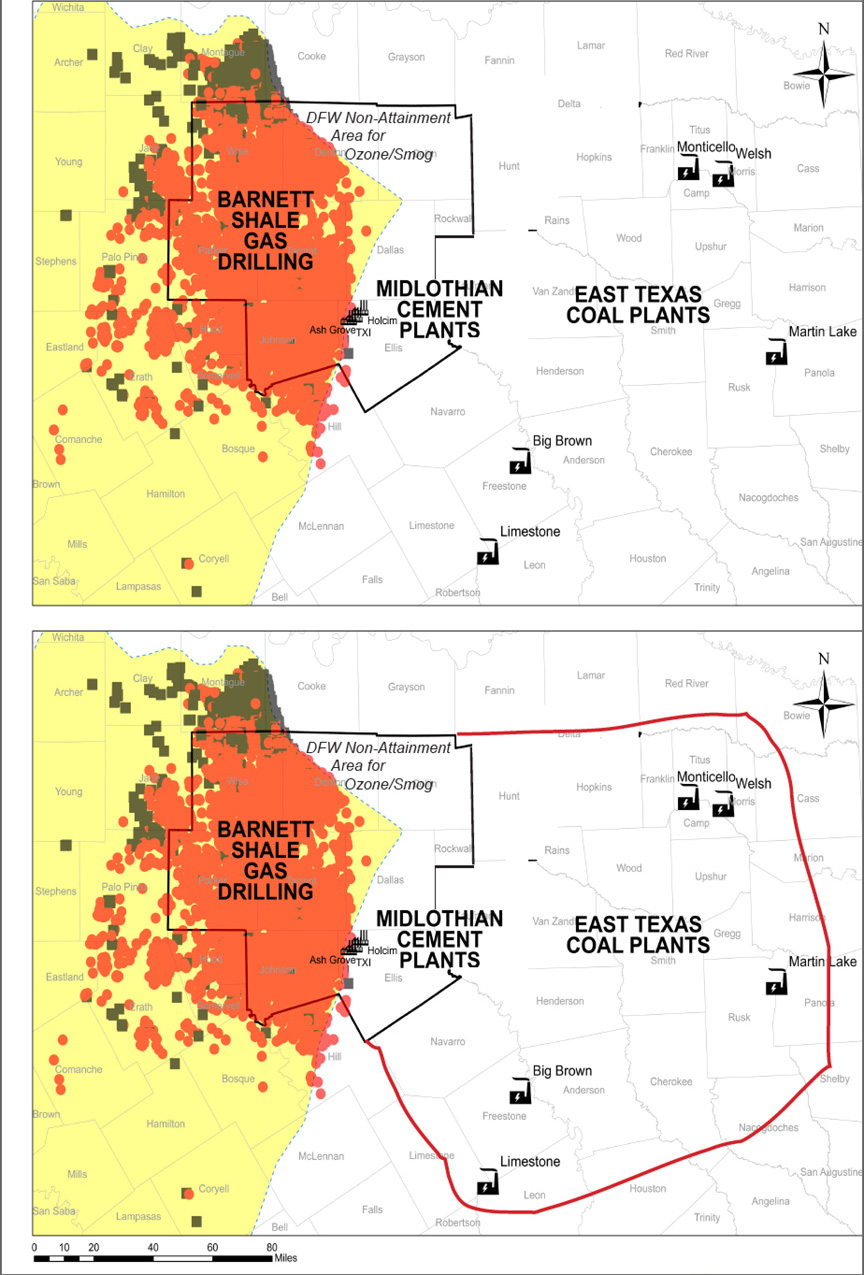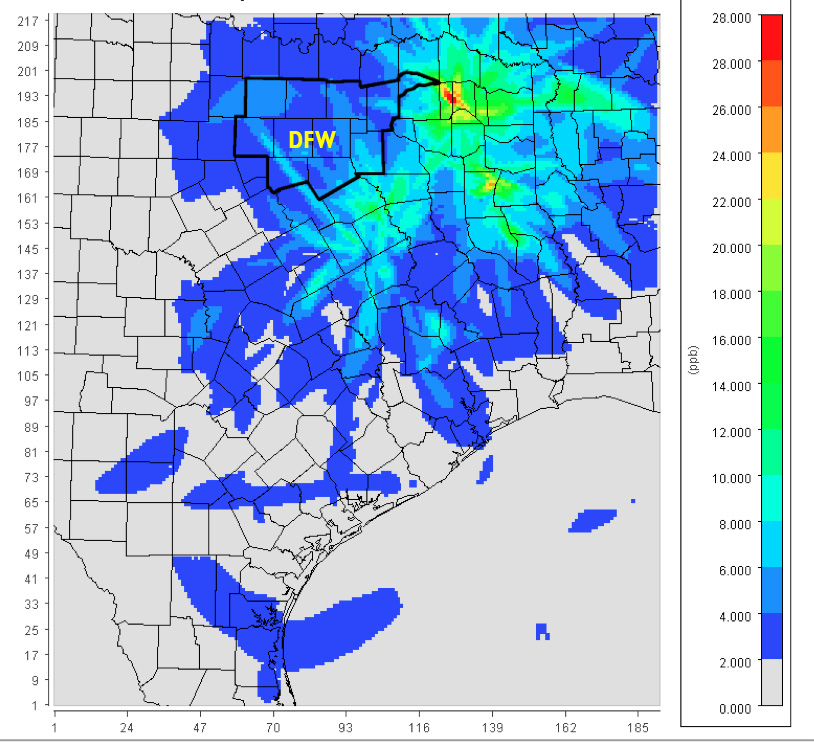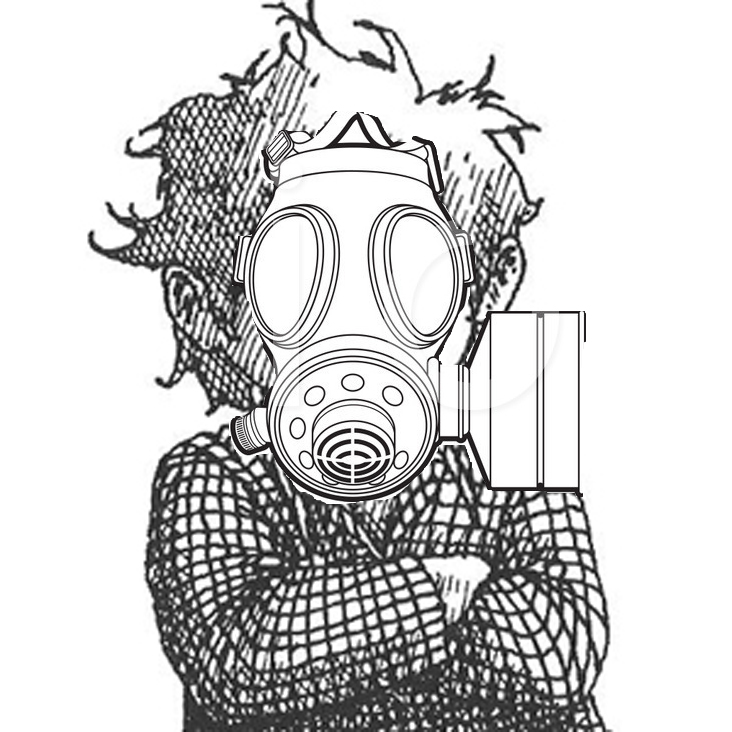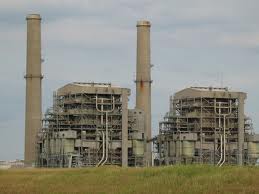Posts Tagged ‘Coal plants’
Bring the East Texas Coal Plants into DFW’s Smog “Non-Attainment Area” and See How Long They Last……
 Want the Coal Plants to Face the Kind of Regulation
Want the Coal Plants to Face the Kind of Regulation
They've Been Avoiding for Decades?
Click here and send a formal comment letter demanding the coal plants
be included in the new DFW non-attainment area for smog.
Even as we're all waiting to see what EPA decides to do about the current Texas air plan for DFW under the current 75 ppb ozone standard, the regulatory process is gearing-up to administer the new 70 ppb standard.
One of the things which must be decided by the EPA are what geographical boundaries to use for the new standard when it comes to the DFW airshed and its chronic smog condition. Should they stick with the current 10-County configuration or should it be different and/or more inclusive?
The history of DFW's smog fight is a lengthy chronicle of bringing new counties into the fold despite official resistance. Originally, the DFW non-attainment area was only Tarrant, Dallas, Collin and Denton. Then Rockwall, Parker, and Johnson Counties came in because of their commuter traffic.
Downwinders had to petition the EPA to bring Ellis County and its cement industrial complex into the non-attainment area early in this century after being told repeatedly by state officials that its pollution had no impact on DFW air quality.
More recently, the state argued against the inclusion of Wise County, despite its huge inventory of oil and gas pollution, population of commuters, and more than likely, the highest ozone levels of anywhere in North Texas. EPA decided to bring it in anyway.
We're once again at a crossroads, and it could be the most significant one in a decade.
 New evidence shows the huge impact the East Texas coal plants have on DFW air quality. Every scenario run by the UNT Engineering Department with the state's own DFW air computer model as part of Downwinder's Ozone Attainment Project demonstrates there's no more effective smog fighting strategy than reducing or eliminating the pollution from these coal plants.
New evidence shows the huge impact the East Texas coal plants have on DFW air quality. Every scenario run by the UNT Engineering Department with the state's own DFW air computer model as part of Downwinder's Ozone Attainment Project demonstrates there's no more effective smog fighting strategy than reducing or eliminating the pollution from these coal plants.
In fact, with a few other measures within the DFW area itself, controlling or eliminating their emissions could bring us in compliance with the 75 ppb standard, something that's not likely to happen otherwise.
Why is it so important to officially bring them into the DFW non-attainment area? Because major sources of pollution like coal plants are regulated differently inside than they are outside the area.
Right now, many DFW businesses are having to pay to operate and maintain pollution control equipment although most emit a tiny fraction of the pollution coming from the coal plants. That's because they're located in one of the ten counties in the DFW non-attainment area. They're held to a higher standard of control than their peers doing business outside those ten counties.
On the other hand, despite their large contribution to DFW's chronic ozone problem, the East Texas coal plants remain untouched by the same regulations and are not held to that higher standard. What sense does that make?
As much sense as it made to keep the cement plants out. As much sense as it made to try and exclude Wise County.
As per usual, the EPA is letting the state have first crack at defining a new DFW smog zone. The state has decided to leave the boundaries the way they are.
 Now, it's your turn to comment on that state decision, and tell Austin and the EPA – which will review the State's recommendations – what you think needs to happen.
Now, it's your turn to comment on that state decision, and tell Austin and the EPA – which will review the State's recommendations – what you think needs to happen.
The state is accepting comments on its decision until April 15th. This time, you can send your comments directly by e-mail instead of having to go through the official Texas Commission on Environmental Quality website
If you want to use our ready-to-send letter, all you have to do is CLICK HERE , sign the letter and add your own comments if you want. Then one more click and it's on it's way to Austin.
If you want to write your own comments:
EMAIL: kristin.patton@tceq.texas.gov
SNAIL MAIL: Kristin Patton, MC 206, State Implementation Plan Team, Office of Air, Texas Commission on Environmental Quality, P.O. Box 13087, Austin, Texas 78711-3087,
FAXED:(512) 239-6188.
All comments should reference "2015 Ozone NAAQS Designation Recommendations."
TCEQ’s Terrible, Horrible, No Good, Very Bad Air Plan for DFW

TCEQ Public Hearing on the new DFW Anti-Smog Plan
Thursday, January 15th 6:30 pm
Arlington City Hall, 101 W. Abram
Over the last two decades, we've seen some pretty lame DFW clean air plans produced by the state, but the newest one, scheduled for a public hearing a week from now, may be the most pathetic of the bunch.
From a philosophical perspective, the Texas Commission on Environmental Quality stopped pretending to care about smog in DFW once Rick Perry decided to run for president around 2010 or so. Computer modeling was scaled back, staff was slashed, and the employees that were left had to be ideologically aligned with Perry's demand that no new controls on industry (i.e potential or existing campaign contributors) was preferable to six or seven million people continuing to breathe unsafe and illegal air.
TCEQ's 2011 anti-smog plan reflected that administrative nonchalance by concluding – in the the middle of the Great Recession – that consumers buying new cars would single-handedly deliver the lowest smog levels in decades. It did not. It went down in history as the first clean air plan for the area to ever result in higher ozone levels. The first, but maybe not the last.
This time around, it's not the cars themselves playing the role of atmospheric savior for TCEQ, but the fuel they'll run on. Beginning in 2017, the federal government is scheduled to introduce a new, low-sulfur gasoline that is predicted to bring down smog by quite a bit in most urban areas. Quite a bit, but not enough to reach the ozone standard of 75 ppb that's necessary to comply with the Clean Air Act by 2018. It's the gap between this official prediction and the standard where the state is doing a lot of hemming and hawing.
TCEQ staffers really did tell a summertime audience in Arlington that that estimated 2018 gap of between 1 and 2 ppb was "close enough" to count as a success. Now, you might give them the benefit of the doubt, but remember this is an agency that has never, ever been correct is its estimation of future ozone levels. After five attempts over the last two decades, TCEQ has never reached an ozone standard in DFW by the official deadline. Precedent says this plan won't even get "close enough."
Plus, we know getting "close" to 75 ppb isn't protecting public health in DFW. Even as this clean air plan is being proposed by Austin, the EPA is moving to lower the national ozone standard to somewhere between 60 and 70 ppb (There's a hearing on that at Arlington City Hall on January 29th). That new EPA ozone standard is due to be adopted by the end of this year. So this entire state plan is obsolete from a medical perspective. Instead of aiming for a level of ozone pollution closer to 70 ppb as soon as possible, it's not even getting down to a flat 75 ppb at all DFW monitors by 2018. It wil take an entirely new plan, and pulling TCEQ teeth, to do that much later. In other words, millions of people will have to wait as much as a five to seven years longer to get levels of air quality we know we need now in 2015.
What are the major flaws this time?
1. TCEQ is Using 2006 in 2014 to Predict 2018.
The EPA recommends that states use an "episode" of bad air days from the last three years – 2009-2013 – in trying to estimate what ozone levels will be three years from now. The more recent the data, the better the prediction.
TCEQ is ignoring that recommendation, relying on a computer model that's already nine years old. This has all kinds of ramifications on the final prediction of compliance. Instead of having more recent weather data, you have to "update" that variable. TCEQ doesn't have to compensate for the drought DFW is experiencing now or factor in a year like 2011 where the drought caused a worst case scenario for ozone formation.
TCEQ isn't using more recent data on how sensitive monitors are to Nitrogen Oxide (NOx) and Volatile Organic Compounds (VOCs) – the major kinds of pollution that cause smog . That's important because gas production in the Barnett Shale has put a lot more VOCs in the air. But instead of getting a more accurate post-drilling boom read on what's driving smog creation, the TCEQ is relying on a picture that starts out before the boom ever started.
The further you reach back in time for a model to predict future levels of smog, the fuzzier that future gets, and the less accurate the results. TCEQ is using a model that's twice to three times older than EPA guidance recommends. What are the odds that TCEQ estimates will be correct based on this kind of methodology?
2. TCEQ is Downplaying OIl and Gas Pollution
Citizens attending the air quality meetings in Arlington over the past year have seen the TCEQ try and hide the true volume and impact of oil and gas pollution at every turn. Instead of all the industry emissions being listed under the single banner of "Oil and Gas Pollution," the Commission has tried to disperse and cloak them under a variety of categories in every public presentation.
"Other Point Sources," a classification that had never been seen before, was the place where pollution from the 647 large compressor stations in DFW could be found – if you bothered to ask. "Area Sources" was where the emissions from the thousands of other, smaller compressors could be found – again, only if you asked. "Drilling" was separate from "Production." And despite other agencies being able to tease out what kind of pollution came from the truck traffic associated with fracking within their jurisdictions, the TCEQ never bothered to estimate how much of the emissions under "Mobile Sources" was generated by the Oil and Gas industry.
The reason the TCEQ has tried so hard to hide the true volumes of oil and gas pollution is because once you add up all of these disparate sources, the industry becomes the second largest single category of smog-forming pollution in DFW, second only to on-road cars and trucks (and remember many of those trucks are fracking-related). According to TCEQ's own estimates, oil and gas facilities in North Texas produce more smog-forming VOC pollution than all of the cars and trucks in the area combined, and more smog-forming NOx pollution than the Midlothian cement plants and all the area's power plants combined.
TCEQ is loathe to admit the true size of these emissions and place them side-by-side next to other, traditional sources, lest the public understand just how huge a impact the oil and gas industry has on air quality. Austin's party line is that this pollution isn't contributing to DFW smog – that it's had no impact on local air quality. But such a claim isn't plausible. If cars are a source of smog, and cement kilns and power plants are a source of smog, how can a category of VOC and NOx pollution dwarfing those sources not also be a source of smog? Think how much less air pollution we'd have if the Barnett Shale boom of the last eight years had not taken place?
In it's last public presentation in August, the TCEQ made the impact of oil and gas pollution clear despite itself. According to the staff, oil and gas emissions were going to be decreasing in the future more than they had previously estimated. As a result, a new chart showed that certain ozone monitors, including the one in Denton, would see their levels of smog come down significantly. It was exactly the proof of a causal link between gas and smog that TCEQ had been arguing wasn't there. Only it was.
In terms of forecasting future smog pollution, TCEQ is underplaying the growth of emissions in the gas patch. Everything it's basing its 2018 predictions on is years out-of-date, leftover from its last plan.
Drilling rig pollution is extrapolated from a 2011 report that counts feet drilled instead of the actual number of rigs. TCEQ predicts a decline in drilling and production in the Barnett Shale without actually estimating what that means in terms of the number of wells or their location. It also assumes a huge drop-off in gas pollution after 2009 that hasn't been documented by any updated information. It's only on paper.
While recent declines in the price of oil and gas have certainly put a damper on a lot of drilling activity, there's still a significant amount going on. Look no further than Mansfield, where Edge is now applying for permit to build a new compressor and dozens of new wells on an old pad.
In 2011, nobody was building Liquified Natural Gas terminals up and down the Gulf Coast for an export market the way they are now. Analysts say those overseas markets could produce a "second boom" in drilling activity between now and 2018, but the TCEQ forecasts don't take that into account.
Gas production pollution numbers – emissions from compressors, dehydrators, storage tanks – are even more tenuous. Every gas industry textbook explains that as gas plays get older, the number of lift compressors increases in order to squeeze out more product. Increase the number of compressors and you increase the amount of compressor pollution. But TCEQ numbers fly in the face of that textbook wisdom and predict a decline in compressor pollution because wells in the Barnett Shale are getting older!
The best analogy for how TCEQ is estimating oil and gas pollution is its poor understanding of where those thousands of smaller compressor are and how much pollution they're actually producing. No staff member at TCEQ can tell you how many of those compressors there are in the region – they literally have no idea and no idea of how to count them in the real world. There are just too many, their locations are unknown, and they were never individually permitted.
Instead, the TCEQ takes production figures from the Railroad Commission and guesses how many of those small compressors there are, as well as their location, based on where the RRC tells it production is going on in the Shale. Then staff guesses again about the emissions being emitted by those compressors, because there's no data telling them what those emissions actually are. In the end you have a series of lowballed guestimates, stacked one atop the other, presented as fact. It's smoke and mirrors.
3. TCEQ Isn't Requiring Any New Controls on Any Major Sources of Air Pollution
Like its previous 2011 DFW air plan, which resulted in an increase in North Texas ozone levels, TCEQ's new plan requires no new controls on any major sources of air pollution, despite evidence showing that such controls in smog-forming emissions from the Midlothian cement plants, East Texas coal plants, and Barnett Shale gas facilities could cut ozone levels significantly.
Selective Catalytic Reduction (SCR) is already used extensively in the cement plant industry in Europe to reduce smog pollution by up to 90%. Over a half dozen different plants have used the technology since 2000. The TCEQ's own 2006 report on SCR concluded it was "commercially available." Holcim Cement has already announced it will install SCR in its Midlothian cement plant. Yet the TCEQ makes no mention of this in its plan.
That's right, a cement plant in Midlothian has decided SCR is commercially viable, but the State is looking the other way and pretending this development in its own backyard isn't even happening. TCEQ is stating in its proposed plan that SCR just isn't feasible!
In 2013, a UTA Department of Engineering study looked at what happened if you reduced Midlothian cement plant pollution by 90% between 6 am and 12 Noon on weekdays. Ozone levels went down in Denton by 2 parts per billion. That may not seem like a lot, but in smog terms it's the difference between the Denton air monitor violating the 75 ppb standard under the TCEQ plan and complying with the Clean Air Act.
In 2012 a UTA College of Nursing study found higher rates of childhood asthma in Tarrant County "in a linear configuration" with the plumes of pollution coming from the Midlothian cement plants. SCR means less pollution of all kinds: smog, dioxins and the particulate matter the Nursing College thought was causing those increased rates of childhood asthma. By delaying the requirement that all the Midlothian cement plants install SCR by 2018, the state is turning its back on a problem that Cook Children's hospital described as "an epidemic."
The same is true of SCR in the East Texas coal plants. The technology is being used in other coal plants around the world and in the US to reduce smog pollution. There's no reason it shouldn’t be required for the dirtiest coal plants in Texas that impact DFW air quality. After decades of being out of compliance with the Clean Air Act, DFW is one of the places the technology is needed most.
Last year the Dallas County Medical Society, led by Dr. Robert Haley, petitioned the TCEQ to either close those coal plants or install SCR on them. The doctors' petition was rejected by TCEQ Commissioners and they were told their concerns would be addressed in the DFW air plan. They aren't. Those concerns, along with the proof they presented about the impact of the plants on local air quality, are being ignored.
Electrification of gas compressors is a commonly used technology that could cut smog pollution as well, and yet the TCEQ is not requiring new performance standards that would force operators of hundreds of diesel and gas-powered compressors in North Texas to switch to electricity.
A 2012 Houston Advanced Research Center study found that pollution from a single compressor could raise local ozone levels by as much as 3 to 10 ppb as far away as ten miles. There are at least 647 large compressor stations in the western part of the DFW area. Dallas and other North Texas cities have written ordinances requiring only electric-powered compressors within their city limits based on testimony from industry that electrification was a commonly used technology in the industry. And yet, TCEQ's official position is that electrification isn't feasible.
In ignoring these types of new controls the TCEQ is violating provisions of the Clean Air Act to implement "all reasonably available control technologies and measures" to insure a speedy decrease in ozone levels. Each of these technologies is on the market, being used in their respective industries, and readily available. Studies have shown that each of these technologies could cut ozone levels in DFW significantly, but the TCEQ is refusing to implement them. In doing so, many observers believe it's blatantly in violation of the law.
We don't expect TCEQ to change its position. That well has been poisoned for the foreseeable future. But we do expect a higher standard of enforcement from the Obama Administration EPA. That's why we're asking you to show-up at the public hearing and oppose this dreadful state air plan a week from now in Arlington. We need to demonstrate to the federal government that citizens are concerned about getting cleaner air now, not in the next plan or the one after that. Now. We need to put pressure on the EPA to reject this TCEQ plan, to either send it back to the drawing board or substitute one of its own. Without you showing up, that pressure isn't there.
Between now and Thursday – and all the way through January 30th, you can send prepared comments opposing the TCEQ plan to Austin and the EPA Regional Administrator with a simple click here – and add your own comments as well.
As a reward for coming over and venting your frustration, we'd like you to stay and party with us at the official "retirement party" of State Representative Lon Burnam, beginning at 7:30 pm just four blocks down the street. It's a roasting and toasting of the best friend environmentalists ever had in the Texas Legislature, as well as a fundraiser for Downwinders to continue our work to defend your air. JUST CLICK HERE FOR TICKETS.
Next Thursday you can support clean air two ways in one evening. Help us beat back a terrible, horrible, no good, very bad air plan, and then come celebrate the wonderful, righteous, very good work of a dedicated public servant. See you there.
Remember Those East Texas Coal Plants?
 The Sierra Club does. Funded by a $50 million donation from New York Mayor Michael Bloomberg, its Beyond Coal campaign is coming to Dallas-Ft. Worth to take on the old TXU, the operator of some of the most polluting coal plants in the nation, including Martin Lake, the third largest stationary source of Greenhouse Gas pollution in the nation.
The Sierra Club does. Funded by a $50 million donation from New York Mayor Michael Bloomberg, its Beyond Coal campaign is coming to Dallas-Ft. Worth to take on the old TXU, the operator of some of the most polluting coal plants in the nation, including Martin Lake, the third largest stationary source of Greenhouse Gas pollution in the nation.
Hoping to persuade customers to switch electricity providers, as well as hit the plants as contributors to the chronic regional smog problem, the Club is sending at least two organizers up to North Texas from Austin on a regular basis. They'll be supervised by former Downwinder technical adviser and EPA Regional Administrator Dr. Al Armendariz, who's now heading up the Texas franchise of Beyond Coal.
Although some might argue that gas mining in the Barnett Shale has replaced the threat the coal plants represented seven years ago when Governor Perry attempted to fast track the permitting of over a dozen new ones, the old TXU ones still release formidable amounts of pollution because they're so old. A new Texas Tribune interview with Dr. Armendariz lays out the campaign's strategy for taking them on.
